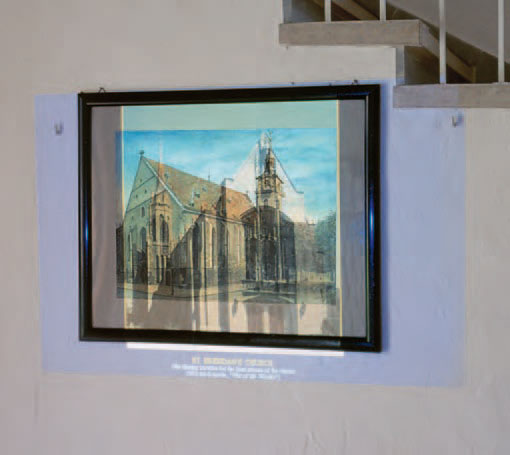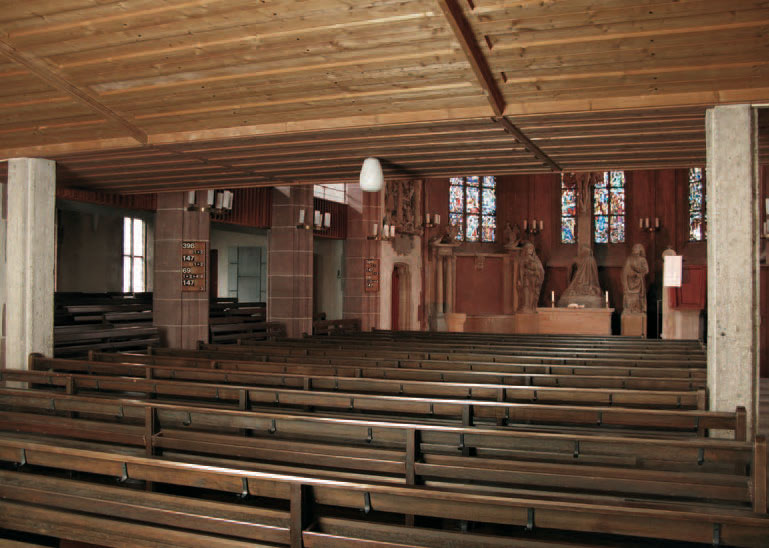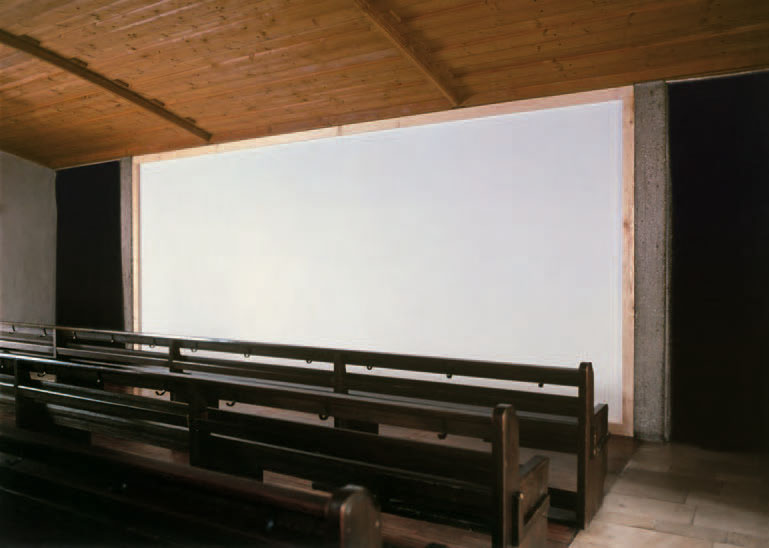vakuole
__

2001
Installation
Hospitalhofkirche, Stuttgart
Installationsansicht
Installation view

Im Mittelschiff der Stuttgarter Hospitalkirche befand sich eine Leinwand, wodurch ein kleines Kino mit Kirchenbänken im Sakralraum entstand. Jeder Besucher musste diesen Raum („Vakuole“ – eigentlich ein in einer Zelle liegender größerer Raum) passieren, um in den Altarbereich zu gelangen. In dieser räumlichen Anordnung sind u. a. die Momente des Lichts und der Dunkelheit, die Erleuchtung des Altars wie der Kinoleinwand in der Zentralperspektive des Zuschauers oder das Öffnen wie Schließen von Vorhängen an beiden Orten – Kino wie Kirche – enthalten. Auf die Rückseite der Leinwand wurde ein Dia projiziert. Dabei handelt es sich um eine Doppelbelichtung, die sowohl den Ausstellungsort Hospitalkirche Stuttgart und die St. Brendan Church in Los Angeles zeigt.
Diese sakralen Räume werden heute in verschiedener Weise genutzt. In der Hospitalkirche zeigt man zeitgenössische Kunst, und St. Brendan dient als Location für die Filmindustrie Hollywoods. Dort drehte man u. a. im Jahr 1953 die Schluss-Szenen des Science-Fiction-Filmes Kampf der Welten nach dem Roman von H. G. Wells. Im international konzipierten Stadtmarketing von Los Angeles werden die authentischen Drehorte Hollywoods zu Tourismuszielen ausgebaut und die Filmgeschichte zu dem bestimmenden Element der Geschichtsschreibung dieser Stadt.
In dem Film Kampf der Welten bildet diese reale Kirche die Filmkulisse für den letzten Zufluchtsort der wenigen Menschen, die eine Invasion der Außerirdischen überlebten. Nach Horror und Angst endet er, wie viele andere Produktionen Holly-woods, mit der Erlösung der ganzen Menschheit. Das Kino formuliert in Ästhetik, Architektur und Geschichten Ansprüche, die auch in der Religion enthalten sind, und gelegentlich wirkt Hollywood selbst wie eine weltumspannende Religion.
A screen was placed in the central nave of the Hospitalkirche (hospital church) in Stuttgart, which created a small cinema with pews within the church. Every visitor had to pass through this space to get to the altar area. In this arrangement of space, there were moments of light and darkness, the illumination of the altar and the cinema screen in the central perspective of the observer, and the opening and closing of the curtains in both places – which were both cinema and church at the same time. A slide image was projected onto the back of the screen. It was a double exposure, showing both the exhibition location – the Hospitalkirche Stuttgart – and St. Brendan Church in Los Angeles.
These church rooms are today used in various ways. At the Hospitalkirche, contemporary art is shown, and St. Brendan serves as a location for the Hollywood film industry. In 1953, it was used for the shooting of the final scenes of the science fiction movie War of the Worlds.In internationally oriented Los Angeles, the authentic locations of Hollywood movies have been turned into tourist destinations, and movie history becomes a key element in the historical chronicle of the city.
In War of the Worlds, the real St. Brendan became the set for the last refuge of the few people to survive the invasion of the aliens. After horror and fear, the movie ends, like so many other Hollywood productions, with the salvation of all mankind. In its aesthetics, architecture, and its stories, cinema formulates demands that also exist in religion, and frequently, Hollywood itself is like a religion spanning the world.

